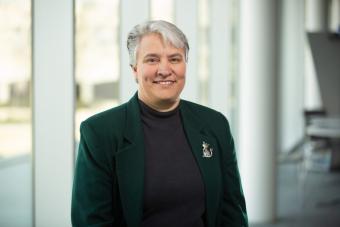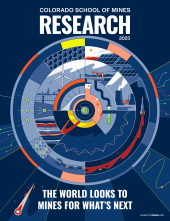Petroleum engineering faculty cracking open enhanced geothermal energy

Jennifer Miskimins, professor and head of the Petroleum Engineering Department, and her team are working on new opportunities for enhanced geothermal technology to help supplement a more sustainable energy future.

By Ashley Piccone, Special to Mines Research Magazine
As the U.S. transitions to clean energy and a net-zero carbon future, renewable energy sources, such as solar and wind, are becoming commonplace. But beneath the surface lies another, less visible but still viable alternative: geothermal energy.
Currently, geothermal energy is focused in areas with naturally hot rock and water, such as locations with volcanic activity. These formations heat underground water sources, turning them into steam that can then be used to generate electrical power.
Jennifer Miskimins, professor and head of the Petroleum Engineering Department, and her team are working on new opportunities for enhanced geothermal technology to help supplement a more sustainable energy future. As a nearly pollution-free resource with the smallest land footprint out of any other energy source, including coal, solar and wind, geothermal energy shows significant promise for being a key player in the clean energy transition.
We spoke with Miskimins about the potential impact of geothermal resources on the world’s energy profile and how we can better tap into the earth to help meet growing energy demands.
What advantages does geothermal energy have compared to other resources?
Miskimins: If certain techniques can be improved — like the enhanced geothermal concepts our team is working on — geothermal could be available almost everywhere in the world. Unlike wind and solar, which can be impeded when the wind stops blowing and the sun is blocked, geothermal is a 24/7 supply chain.
It also overcomes many of the drawbacks to other electricity sources. You don’t need the critical minerals for solar panels and don’t kill raptors and other birds, which is an issue with wind turbines. Geothermal doesn’t require dams and doesn’t need the processing or emissions associated with biofuels.
You’re extending your expertise in hydraulic fracturing to enhance geothermal energy technology through the Utah FORGE project, an underground lab sponsored by the U.S.Department of Energy. What challenges are your team working on?
Miskimins: Enhanced geothermal system (ESG) energy exploits two parallel, horizontal wells by forcing water to move from one to the other through hot rock. The problem with EGS has been fluid “short-circuiting” between wells and only harvesting 1 to 2 percent of the heat before the fluid cools going to a power plant. The rest of the heat is never harvested and the EGS system fails economically.
We have a $5.3 million project, the Utah FORGE project, led by Will Fleckenstein, Director of Strategic Business Development in Global Initiatives, and several petroleum engineering faculty as co-PIs, to build next-generation frac sleeves with Tejas Research and Engineering that can create hydraulic fractures or cracks between the two wells. There is also a high-temperature tractor that can detect the injected “short-circuiting” water and then close the sleeve to force the injected water into fractures that are still hot to harvest more heat and keep the hot water going to the power plant.
To really make this work, the wells are about 4 miles long with a hundred fractures extending hundreds of feet from one well to the next. Without the ability to detect the short-circuiting and then close a valve or sleeve to force the fluid to where the remaining heat exists, no matter how large the system is, the water will always take the path of least resistance – the “short circuit” – and not harvest the massive amounts of free BTUs beneath our feet. We’re working on developing the tools that go into the well to allow us to do that.
What do those tools look like?
Miskimins: First, a well is cased with steel pipe, with the sleeves threadedly connected to the casing, and the casing and sleeves are cemented in place prior to stimulation. We’re working with sleeves that will open with the drop of a single-sized ball, allowing a normal multistage fracturing to be done. When they open, they allow fracturing fluid to go out that point of the casing to create the fracture to the next wellbore. We’re also working on a high-temperature tractor to go down in the well to close these sleeves up when they need it. In essence, it’s like turning off different faucets along the well bore to make sure the fluid coming out the other production well is still geothermal hot.
Mines is doing a lot of the heat transfer work and a lot of the understanding about how the fractures will initiate out of the well, so that we can design these tools to work correctly. Currently, the tractors and sleeves are being built and tested in Houston for deployment first at the FORGE site in Utah, and then wherever someone wants to create a subsurface heat exchanger that we have been talking about to generate power or district heating,
What is the potential impact of this research?
Miskimins: What has been successful at this point in time has been very geographically limited. The problem is there are very few areas that have the heat, the reservoir and the water. What we are trying to do is copy what made shale development work with long horizontal wells to create a reservoir where there is none, using multistage fracturing, but now we are harvesting heat, not oil and gas. We’ve always sought out areas with hot, volcanic rock, but now enhanced geothermal research is trying to push that temperature down and make the technology more widespread. For example, as certain oil and gas reservoirs and wells deplete, there’s a lot of discussion about recycling these wells for geothermal energy.
Geothermal is currently 2 percent of the overall 12 percent of renewable electricity generation in the U.S. Right now, it is pretty low on the list in terms of supply, but the potential, in terms of expansion and reliability, has a lot of people intrigued.
Why does this research interest you?
Miskimins: If we can make this work, it will phenomenally expand the accessibility of geothermal energy to a lot of people around the world. This project helps us round out one more area of energy that Mines is good at, which is also exciting to me. It’s another opportunity for Mines to shine. From an energy standpoint, we’re pretty much the whole package, and this is another component of that.



